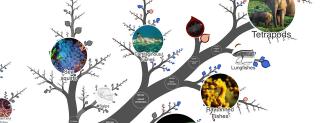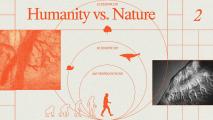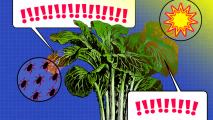British researchers have completed work on OneZoom, an interactive tree of life that lets you explore the evolutionary connections between more than two million species.
All connected: The tree of life is a way of visualizing how all the species on Earth are connected by evolution — every species is represented by a single leaf, and the placement of a leaf on the tree tells you how closely related it is to other species.
Because humans share a recent common ancestor with chimpanzees, for example, their leaf is right next to ours on the same branch, but the leaf for E. coli — a far distant relative — is on the other side of the tree of life.
“Our tool can help represent all Earth’s species and allow visitors to connect with their plight.”
James Rosindell
The idea: More than a decade ago, James Rosindell, a biodiversity researcher at Imperial College London, and Yan Wong, an evolutionary biologist at the University of Oxford, started working on OneZoom, an interactive tree of life.
Their hope was that the site would become “the Google Earth of biology,” and with 2.2 million leaves, it’s now the most comprehensive single-view tree of life ever created.
Online inspiration: Instead of just placing leaves on the tree, the researchers went a step further, color-coding each leaf to symbolize how close a species is to extinction: green (no threat), red (threatened), black (recently extinct), and gray (extinction threat unknown).
Their hope was that, by exploring the tree of life, people might get a better idea of how humans fit into the greater scheme of things on Earth and perhaps be inspired to preserve our planet’s biodiversity.
“Two million species can feel like a number too big to visualise, and no museum or zoo can hold all of them!” Rosindell said. “But our tool can help represent all Earth’s species and allow visitors to connect with their plight.”
Your name here: The researchers also integrated a sponsorship feature into their tree of life, allowing people to pay to adopt specific leaves.
The fee for each leaf is directly linked to a species’ popularity, which is determined by the number of views its page receives on Wikipedia. Humans are currently the most popular species overall, and as for the most popular plant species, cannabis takes the crown.
Money from the sponsorship of leaves supports the OneZoom charity, whose mission is to “advance the education of the public in the subjects of evolution, biodiversity, and conservation of the variety of life on Earth.”
“We hope to send a powerful message: that much of our biodiversity is under threat.”
JameS Rosindell
Why it matters: Preventing a species from going extinct isn’t just important for that species — the loss of one species can affect others up and down the food chain, leading to a ripple effect throughout the ecosystem.
A biodiverse planet — one with a lot of different species — is also beneficial to human health. Many useful medicines come from plants, animals, and fungi, and the more species we have to study, the better our chances of finding new ones.
“We have worked hard to make the tree easy to explore for everyone, and we also hope to send a powerful message: that much of our biodiversity is under threat,” Rosindell said.
We’d love to hear from you! If you have a comment about this article or if you have a tip for a future Freethink story, please email us at [email protected].





